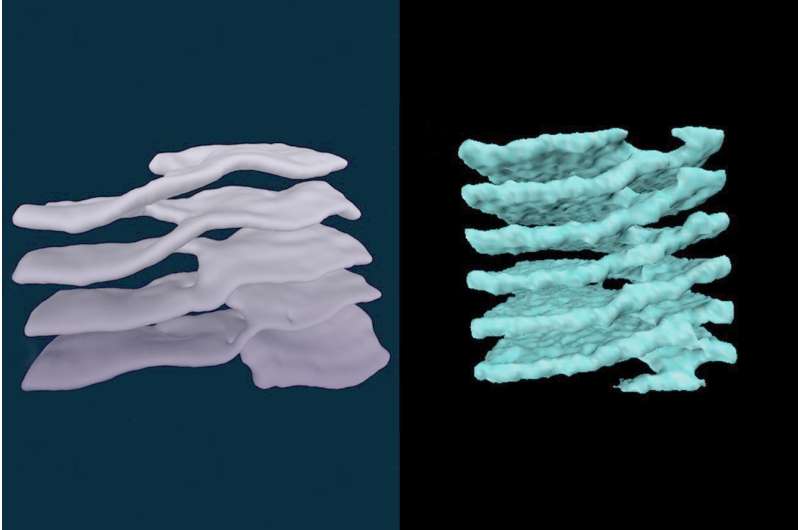Of parking garages, nuclear pasta, and cosmic connections

Sometimes science can be serendipitous.
Certainly that was the case when former UConn professor Greg Huber came across an image in a physics journal that looked like the stacked, evenly spaced layers of a multistory parking garage. A team of researchers was announcing that such structures may exist deep in the outer crust of neutron stars as a form of nuclear pasta. (More on that later.)
To Huber, the image was something completely different. It was a classic display of microscopic structures found in cellular cytoplasm that he and his UConn colleagues helped discover several years earlier. In a 2014 paper, Huber dubbed them 'Terasaki ramps' after UConn cell biologist Mark Terasaki, his former colleague (and West Hartford neighbor), who was the first to spot them.
But these new structures were a long way from home. How the strikingly similar shapes came to appear in both tiny living cells on Earth and massively dense inanimate neutron stars thousands of light-years away, fascinated Huber. He contacted the journal publication's senior researcher, Charles Horowitz, a nuclear physicist at Indiana University, who just happened to be one of Huber's former professors when he attended MIT. (More serendipity?)
After Huber and Horowitz spoke, they realized the potential benefits of a collaboration. Their probe of the structural similarities appears this month in the journal Physical Review C.
"I basically told him (Horowitz) that we see very similar things in the endoplasmic reticulum of eukaryotic cells," says Huber, a soft matter biophysicist now serving as the deputy director of the Kavli Institute for Theoretical Physics at the University of California, Santa Barbara. "We see the same evenly spaced sheets connected by spiral ramps (the parking garages). We also see similar three-way tubular junctions with 120-degree angles just like they were seeing."
The Terasaki ramps found in cells are believed to help maximize protein synthesis by providing a greater surface area for ribosomes to pack together and build proteins.
The 'parking garage' structures found in neutron stars appear to play a much different role.
While the neutron star's structural motifs seem nearly identical to those Huber and Terasaki found inside cells, the physical scales and energy levels are off the charts. Neutron stars form when larger stars die and collapse in on themselves. They are the smallest and densest stars known to exist. The only thing denser is a black hole. A neutron star's outer crust is 14 orders of magnitude denser than the aqueous environs of a cell. The star's gravitational field is 2×10¹¹ times that found on Earth, and neutron stars can rotate several hundred times a second.
Cellular-scale biology on the other hand relies on, what seems to us, a relatively mundane environment dominated by the entropy of water and the assembly of biomolecules. The two objects couldn't be any more different in terms of temperature scales, pressure scales, length scales, etc., says Huber. Yet geometrically, their 'Terasaki ramp' parking garage-like structures appear the same.
"In physics, we oftentimes see that nature uses similar shapes even though the underlying materials are completely different," says Huber. "There is a pattern that is deeper than the details of the stuff that makes it up."
Huber's and Horowitz's research raised intriguing questions.
One of their initial conclusions was that the Terasaki ramp shapes may be dictated as much by the rules of geometry as anything else, and may be independent of other microscopic considerations.
In neutron stars, the structures may reduce electrical and thermal conductivity in the star's crust, impact the way the crust cools, and possibly play a role in the eventual decay of the star's magnetic fields, Huber and Horowitz say. Or not. Alternatively, the layered sheets and helical ramps may allow protons to percolate throughout the neutron star's outer system, making it superconducting.
This initial study, Huber says, is only the beginning of a new path for research.
With neutron stars so far away, nuclear physicists like Horowitz rely on advanced computer modeling to illustrate their various theories. The different structures that have been identified in neutron stars are known as 'nuclear pasta' due to their pasta-like shapes. There is a ribbon-like spaghetti phase, a sheet-like lasagna phase, and even a compact gnocchi phase. The different phases form in an intense transition region between the star's outer shell and ultra-dense core.
But now that a connection has been made with Terasaki ramps, nuclear physicists should be able to borrow ideas from the cellular-level studies that are being done to enhance their own modeling of how physical forces are shaping something as large and unknown as neutron stars.
"One way to view it is that physics uses structures over and over again," says Huber. "It's almost as though physics recycles structures and fundamental motifs. The same equations appear despite what the system is. We see similar patterns despite huge disparities in scale and energy. Using this new information, we can make better models that might help us learn more about why a neutron star's crust behaves in a certain way."
It has been said that we all owe a certain debt of gratitude to stars, as the fundamental elements of life – hydrogen, oxygen, iron, carbon – came from stardust. But Huber and his colleagues are happy to leave questions regarding our universal interconnectedness to the philosophers. For now, their focus is on 'pasta,' 'Terasaki ramps,' and those mysterious neutron stars spinning in the sky.
More information: D. K. Berry et al. "Parking-garage" structures in nuclear astrophysics and cellular biophysics, Physical Review C (2016). DOI: 10.1103/PhysRevC.94.055801
Jemal Guven et al. Terasaki Spiral Ramps in the Rough Endoplasmic Reticulum, Physical Review Letters (2014). DOI: 10.1103/PhysRevLett.113.188101
Journal information: Physical Review Letters
Provided by University of Connecticut




















